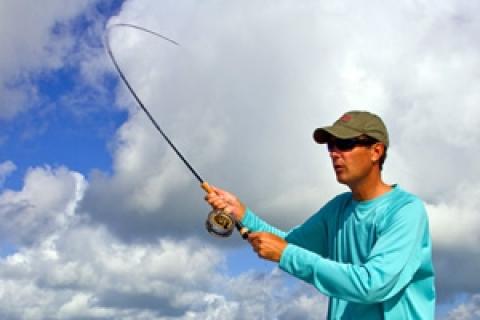
Several things related to fly fishing can be confusing to a beginner. Rod action is one of them. Here's an in-depth look at fly rod actions and their advantages and disadvantages.

The term action refers to the flexibility of the rod. Action is nothing more than a fancy measure of rod flexibility contributing to the idea that fly fishing is complicated. However, the idea is simple.
There are three types of fly rods that beginners should know about. These rods are differentiated by the amount of flex, or action, in the rods. The amount of action in a particular rod is measured on the backcast. The more bend in the rod on the backcast, the more action it contains.
 |
| A general idea of what action means in fly rods — fast offers less flexibility. |
Types of Fly Rod Actions
Fast Action or Tip-Flex
A fast action fly rod is what the name implies. At the end of the backcast, the rod tip will have more movement, or action, than the other classes of rods. The tip will bend, while the remainder of the rod will stay straight. The tip flex rod has advantages in the following situations:
- Need for a long cast. The stiffness of the rod equals more power in the cast.
- Windy days. A stiff rod cuts through the wind easier, making for an easier cast.
- Demands less strength. The power contained in fast action rods means that the angler has to expend less energy to cast the same distance with a slower action rod.
The disadvantages of a fast action rod include:
- Fast action rods can be difficult for beginners. The amount of power in these rods can make it difficult to feel the fly line and fly. Therefore, precise casts will be difficult, at first, for beginners.
- They are not the best rods available for short casts. A more flexible rod provides greater accuracy and a smoother touch.
- Fast action rods are not the best choice for smaller streams. Because of the flex tip, beginners will find themselves slapping the line and fly on the water. The noise generated from this scenario will cause fish to flee.
Medium Action of Mid-Flex
Medium action fly rods are a good choice for beginners. They are the most versatile of all actions. They perform well in a wide variety of situations. Too, they are more user friendly than other actions. On the backcast, a medium action fly rod will bend from about half way down the rod.
If you can own just one fly rod, it should be a medium action rod. It will serve a wider variety of purposes than either a fast action or a slow action fly rod.
Slow Action or Full-Flex
Slow action rods are the most flexible of the three actions. On the backcast, a slow action rod will bend starting about one quarter the way down the rod. At full backcast, the rod will arch into semi 90-degree angle, thus slowing the action and power of the rod.
Slow action rods are ideal for fishing small streams and tight spots where stealth and quiet are essential for success. The slow action rod will prevent much of the slapping of the water surface with both fly and line. Most importantly, slow action rods are forgiving and user friendly. However, they lack the degree of utility found in faster action rods.
Conclusion
If you are still having problems deciding which action rod to choose, stop by your local Bass Pro Shops and speak with one of the many fly fishing experts. The only thing those guys like more than catching a fish on a fly is helping someone else get started in fly fishing.
- 4942 views

